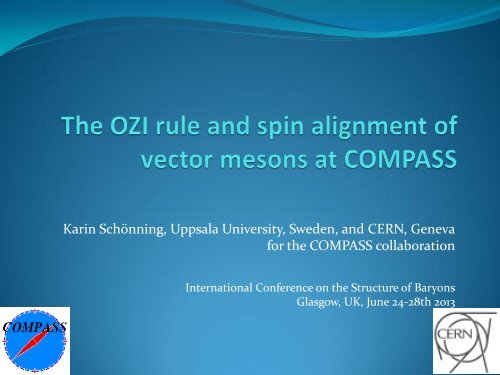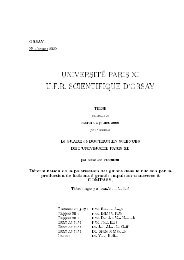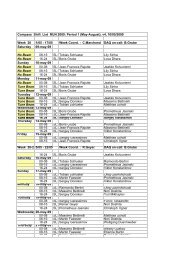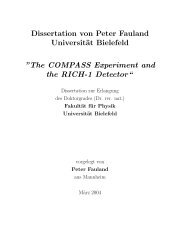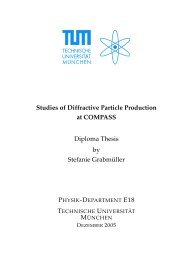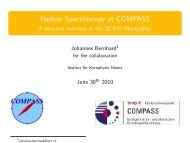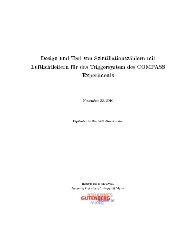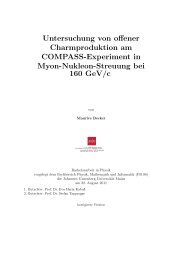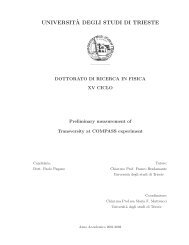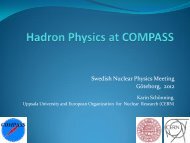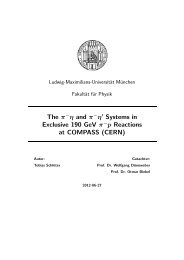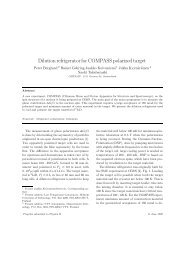V - Compass - CERN
V - Compass - CERN
V - Compass - CERN
You also want an ePaper? Increase the reach of your titles
YUMPU automatically turns print PDFs into web optimized ePapers that Google loves.
Karin Schönning, Uppsala University, Sweden, and <strong>CERN</strong>, Geneva<br />
for the COMPASS collaboration<br />
International Conference on the Structure of Baryons<br />
Glasgow, UK, June 24-28th 2013
Outline<br />
• Introduction<br />
• The COMPASS experiment<br />
• Analysis<br />
• Event selection<br />
• Acceptance and background subtraction<br />
• Results<br />
• M(p fast V)<br />
• R(φ/ω) as a function of x F (p fast ) and p V<br />
• Spin alignment in the helicity frame<br />
• Spin alignment in the exchange particle frame<br />
• The relation between spin alignment<br />
and R(φ/ω)<br />
• What do we learn from this?
Introduction: The OZI rule<br />
• The Okubo-Zweig-Iizuka (OZI)* rule states that processes with disconnected<br />
quark lines are supressed.<br />
• Production of φ should then be allowed only thanks to deviation from ideal<br />
mixing, δ V = 3.7 o , and be suppressed w.r.t. ω production according to<br />
(AB →φ X)/(AB →ωX) = tan 2 δ V = 4.2 · 10 −3 **<br />
where A, B and X are non-strange hadrons.<br />
* S. Okubo, Phys. Lett. 5 (1963) 165, G. Zweig, <strong>CERN</strong> report TH-401 (1964), J. Iizuka, Prog. Theor. Suppl. 38 (1966) 21<br />
** H.J. Lipkin, Phys. Lett. B 60 (1976) 371
Introduction: the OZI rule<br />
• The OZI rule is generally well fulfilled*<br />
• Apparent violations have been observed in<br />
-proton-antiproton annihilations at rest<br />
-NN collisions<br />
-reactions near the kinematic threshold.<br />
• Apparent violation are usually interpreted as<br />
- Intermediate gluonic states**<br />
- A polarised strangeness component in the nucleon***<br />
- Features of the meson-nucleon interaction<br />
* V.P. Nomokonov, M.G. Sapozhnikov, Particles and Nuclei 24 (2003) 184<br />
** S. J. Lindenbaum, Nouvo Cim. 65 A (1981) 222<br />
*** J. Ellis et al. Phys. Lett. B 353 (1995) 319, J. Ellis et al. Nucl. Phys. A 673 (2000) 256
* K. Gottfried & J.D. Jackson, Nuovo Cim. 33 (1964) 302.<br />
** K. Schönning et al., Phys. Lett. B 668 (2008) 258.<br />
***F. Belleman et al., Phys. Rev. C 75 (2007) 015204<br />
Introduction: spin alignment of vector mesons<br />
• Sensitive to the production mechanism *<br />
• Low energy pd experiments show that ω is produced arbitrarily aligned **<br />
whereas φ is produced aligned with the incoming beam. ***<br />
• The differential cross section of the decay of a vector meson into 2 or 3<br />
pseudoscalaras can be parametrised in terms of spin density matrix element and<br />
angles, a lengthy expression which in the case of unpolarised beam and unpolarised<br />
target reduces to<br />
3 1 2<br />
00 ( 3 )<br />
00 1)<br />
cos<br />
W ( cos ) ( <br />
4<br />
where ρ 00 is the zeroth element of the spin-density matrix and θ is the angle between<br />
the analyser and some reference axis.<br />
Analyser:<br />
• the normal of the decay plane in the<br />
3-body case (ω→πππ)<br />
• the direction of one of the decay kaons<br />
in the 2-body case (φ→KK)
The COMPASS experiment<br />
Two-stage magnetic spectrometer:<br />
• Large angular acceptance<br />
• Broad kinematical range<br />
• Tracking, calorimetry, particle ID<br />
Beam: 190 GeV positive (p, π + , K + ) or negative (π - , K - ) hadron beam.<br />
Targets: Liquid H 2 , Nuclear targets (Pb, Ni, W).<br />
Final states: charged (π ± , p, …), neutral (π 0 , η, η’, …),<br />
kaonic (K ± , K S , …)<br />
See also: talks by e.g. B. Grube, Y. Bedfer...
The COMPASS experiment<br />
At the COMPASS beam momentum (190 GeV/c) and with the Recoil Proton Detector<br />
Trigger, events produced by mainly three types of mechanisms are selected:<br />
Resonant diffractive<br />
Non-resonant diffractive<br />
Central Production<br />
Concerning the vector meson dynamics, we consider two cases :<br />
1) The vector meson dynamics depends on the exchange Pomeron/Reggeon (central<br />
production and knock-out of a preformed qq state)<br />
2) The vector meson dynamics depends on the intermediate N *
Analysis: Event selection<br />
Common cuts for φ / ω:<br />
• primary vertex in target volume<br />
• three charged tracks, charge conservation<br />
• beam proton (tagged with CEDARs)<br />
• recoil proton (tagged by RPD)<br />
• exclusivity and coplanarity<br />
• 0.6 < x F (p fast ) < 0.9<br />
• 0.1 < t‘ < 1.0 (GeV/c) 2<br />
Specific cuts for ω: Specific cuts for φ :<br />
• >1 photon in any<br />
of the ECALs<br />
• exactly one π 0<br />
• one π + in RICH<br />
•1.8 < M(pω) < 4.0 GeV/c 2<br />
• one K + in RICH<br />
• 2.1 < M(pφ) < 4.3 GeV/c 2
Analysis<br />
Background subtraction:<br />
A Breit-Wigner function, convoluted with a single (φ) or a<br />
double (ω) gaussian and a polynomial background<br />
was fitted to the data in order to extract the φ and ω yields.<br />
Acceptance corrections:<br />
Event-by-event weighting using a 3D-acceptance matrix<br />
in x F (p fast ), t‘, M(p fast φ)<br />
Overall systematic uncertainty: 12.5%<br />
ECAL and RICH efficiencies
The M(p fast V) invariant mass<br />
• Clear structures in the M(p fast ω) spectrum<br />
• No visible structures in the M(p fast φ) spectrum<br />
• Poor acceptance at low M(p fast φ)
The M(p fast V) invariant mass<br />
• The M(p fast ω) spectrum varies with x F<br />
• Structures near 1800 MeV/c 2 , 2100 MeV/c 2 and 2600 MeV/c 2
R(φ /ω) as a function of x F<br />
The cross section ratio<br />
R( / )<br />
<br />
has been calculated in 3 bins in x F .<br />
d<br />
( pp p<br />
p)<br />
dxF<br />
d<br />
( pp p<br />
p)<br />
dx<br />
The OZI violation factor is defined by R(φ/ω)/4.2•10 -3. and varies between 2.9 and 4.5,<br />
depending on x F ..<br />
This is consistent with results from SPHINX *<br />
We learned that ω mesons in this kinematic region is produced to a large extent via<br />
intermediate baryon resonances.<br />
What if we remove the resonant region?<br />
F<br />
* S.V. Golovkin et al., Z. Phys. A 359 (1997) 435.
R(φ /ω) as a function of x F<br />
The visible resonances are below M(pω) = 3.3 GeV/c 2 .<br />
This corresponds to a vector meson momentum in the rest system of the<br />
resonance<br />
p<br />
V<br />
of p V = 1.41 GeV/c.<br />
Requiring p V > 1.41 GeV/c gives an<br />
OZI violation factor of ~8.<br />
<br />
This is consistent with SPHINX but also<br />
with near threshold pp measurements<br />
from ANKE, DISTO and COSY-TOF.<br />
2 2 2 2<br />
( M<br />
pV<br />
( mV mp ) )( M<br />
pV<br />
( mV mp<br />
) )<br />
2M<br />
pV
The ρ 00 in the helicity frame<br />
Reference axis: the direction of flight of the N *<br />
resonance in the rest system of the vector meson<br />
The ρ 00 w.r.t M(p fast V) for φ<br />
No significant deviation from isotropy.
The ρ 00 w.r.t M(p fast V) for ω<br />
• Significant deviation from isotropy.<br />
• Clear dependence of ρ 00 on M(pω)
The ρ 00 in the exchange particle frame<br />
The ρ 00 w.r.t x F for φ<br />
• Strong alignment with respect to the exchange Pomeron/Reggeon<br />
• Alignment increases with x F
The ρ 00 in the exchange particle frame<br />
The ρ 00 w.r.t x F for ω<br />
• Strong alignment, though weaker than for φ<br />
• Cutting in p V gives similar results as for φ
Relation between R(φ /ω) and the<br />
spin alignment<br />
x F<br />
p V<br />
(MeV/c)<br />
ρ hel oo , φ ρ hel oo , ω ρ EX oo , φ ρ EX oo , ω OZI viol.<br />
0.6-0.7 > 0 0.38±0.03 0.289±0.004 0.51±0.03 0.492±0.003 4.5±0.6<br />
0.7-0.8 > 0 0.35±0.02 0.330±0.003 0.58±0.02 0.582±0.002 4.0±0.5<br />
0.8-0.9 > 0 0.39±0.04 0.449±0.003 0.67±0.04 0.572±0.002 2.9±0.4<br />
0.6-0.7 > 1.0 - 0.34±0.01 - 0.39±0.01 7.6±1.0<br />
0.7-0.8 > 1.0 - 0.306±0.006 - 0.527±0.005 9.0±1.1<br />
0.8-0.9 > 1.0 - 0.463±0.003 - 0.577±0.002 4.5±0.6<br />
0.7-0.8 > 1.4 - - - - 7.9±1.1<br />
0.8-0.9 >1.4 - 0.37±0.03 - 0.601±0.005 7.6±1.0
What do we learn from this?<br />
• The role of baryon resonances is ω production is confirmed by the M(pω)<br />
distributions and the spin alignment in the helicity frame.<br />
• No evidence for baryon resonances decaying into pφ was observed: a<br />
consequence of the OZI rule which supresses N * → p φ.<br />
• The OZI violation (by a factor 2.9-4.5) in the resonant region would then be<br />
caused by other contributing processes.<br />
• In the non-resonant region, i.e. p V > 1.41 GeV/c, the OZI violation factor is ~8.<br />
• The spin alignment for ω and φ have the same behaviour in the helicity frame<br />
(isotropic) and in the exchange particle frame (strong alignment that increases<br />
with x F ).
What do we learn from this?<br />
Possible non-resonant mechanisms:<br />
• Bremsstrahlung with subsequent fluctuation into a vector meson : low cross<br />
section and weak sensitivity to the exchange particle<br />
• Central Pomeron-Pomeron fusion Forbidden due to G-parity conservation!<br />
• Central Pomeron-Odderon fusion: completely OZI violating, would give a<br />
much larger OZI violation than the observed one.<br />
• Central Reggeon-Pomeron fusion<br />
• Knock-out of a preformed<br />
the target<br />
qq<br />
state in the beam proton by a Pomeron from


